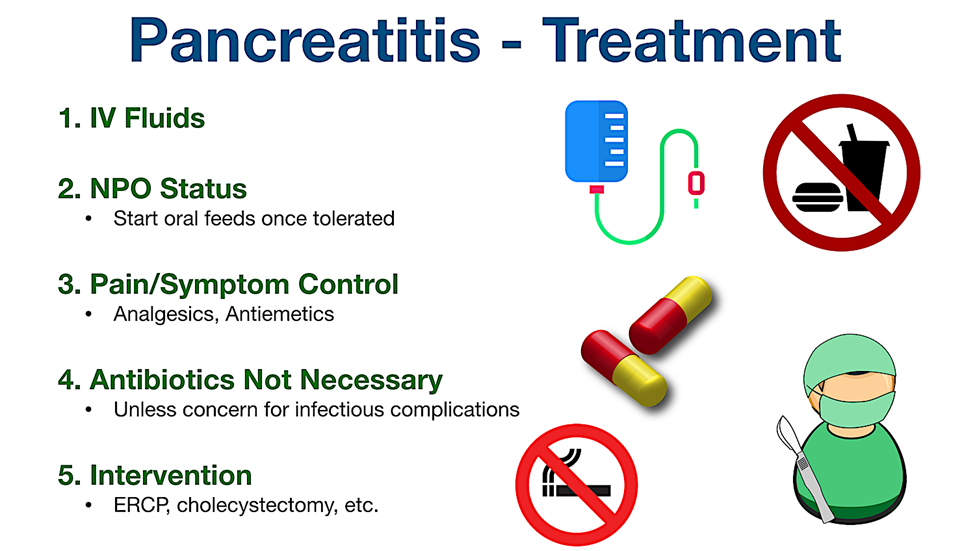A nurse is caring for a client diagnosed with acute pancreatitis. After treating the client's pain, which of the following should the nurse address as the priority intervention?
Provide oral hygiene.
Assist the client to a side-lying position.
Auscultate the client's lungs.
Withhold oral fluids and food.
The Correct Answer is D
A. Provide oral hygiene.
Providing oral hygiene is important for the client's comfort and overall well-being. However, in the context of acute pancreatitis, the immediate priority is to address the gastrointestinal symptoms and prevent further pancreatic stimulation.
B. Assist the client to a side-lying position.
Assisting the client to a side-lying position can be beneficial for comfort and may help prevent complications such as aspiration. However, it is not the immediate priority after treating the pain. Withholding oral fluids and food takes precedence in the initial management of acute pancreatitis.
C. Auscultate the client's lungs.
Auscultating the client's lungs is a routine nursing assessment and is important for respiratory monitoring. However, in the context of acute pancreatitis, the primary focus is on addressing gastrointestinal symptoms, and respiratory assessment becomes more critical if respiratory distress is suspected.
D. Withhold oral fluids and food.
Withholding oral fluids and food is the priority intervention after treating the pain in acute pancreatitis. This is done to reduce pancreatic stimulation, allowing the pancreas to rest and recover. NPO (nothing by mouth) status is often initiated in the early management of acute pancreatitis.

Nursing Test Bank
Naxlex Comprehensive Predictor Exams
Related Questions
Correct Answer is ["A","B","C","D"]
Explanation
A. Increase physical activity and daily exercise.
Regular physical activity helps improve insulin sensitivity, manage blood glucose levels, and lower the risk of cardiovascular complications associated with diabetes.
B. Reduce cholesterol and saturated fat intake.
Managing cholesterol levels and reducing saturated fat intake can help lower the risk of cardiovascular disease, which is a common complication of diabetes.
C. Maintain optimal blood pressure to prevent kidney damage.
Controlling and maintaining blood pressure within optimal ranges is crucial in preventing kidney damage, a common complication of diabetes.
D. Enroll in a smoking-cessation program.
Smoking increases the risk of cardiovascular complications and can exacerbate other diabetes-related health issues. Quitting smoking is important in reducing the risk of complications.
E. Sustain hyperglycemia to reduce deterioration of nerve cells.
Sustaining hyperglycemia (high blood sugar levels) is detrimental and contributes to the progression of diabetic complications, including nerve damage (neuropathy). Lowering and controlling blood glucose levels are essential in preventing complications rather than sustaining hyperglycemia.
Correct Answer is B
Explanation
A. "A weight reduction program will make me hypoglycemic.”
This statement suggests a misunderstanding. Weight reduction programs, when done appropriately, can contribute to better blood sugar control, but they should not necessarily lead to hypoglycemia if managed properly.
B. "I give the insulin injections in my abdominal area.”
This is the correct statement. Injecting insulin into the abdominal area is a common and recommended practice as it allows for consistent absorption and is a well-vascularized area.
C. “Insulin allows me to eat ice cream at bedtime.”
This statement suggests a misunderstanding. While insulin helps manage blood sugar levels, it should not be seen as a means to consume unlimited quantities of high-sugar foods, as a balanced diet is still crucial.
D. "I am to take my blood sugar reading after meals.”
This statement is partially correct. Blood sugar readings are often recommended before and after meals to assess the impact of food intake on blood glucose levels.
Whether you are a student looking to ace your exams or a practicing nurse seeking to enhance your expertise , our nursing education contents will empower you with the confidence and competence to make a difference in the lives of patients and become a respected leader in the healthcare field.
Visit Naxlex, invest in your future and unlock endless possibilities with our unparalleled nursing education contents today
Report Wrong Answer on the Current Question
Do you disagree with the answer? If yes, what is your expected answer? Explain.
Kindly be descriptive with the issue you are facing.
